
Research highlights
Public release of the GREATS data set!
September 2021
Today I am very happy to announce that our paper describing the data release of the GOODS Re-ionization Era wide-Area Treasury from Spitzer (GREATS) program has finally been accepted. We publicly release the mosaics, the PSF maps and catalogs containing deblended flux density extracted from the mosaics in the four IRAC bands for 9192 candidate Lyman-break galaxies at z~3.5-10. These mosaics consitute the deepest data at 3-8um currently available over the CANDELS GOODS-N and GOODS-S fields and are a major resource for the study of distant galaxies while awaiting for JWST. If you want more info on GREATS and/or download the data follow this link. To provide you with a first glimpse of the richness of the data, the picture below was obtained by combining mosaics in the IRAC 3.6um and 4.5um from GREATS and Ks band from the MODS and CFHT programs over the GOODS-N field.
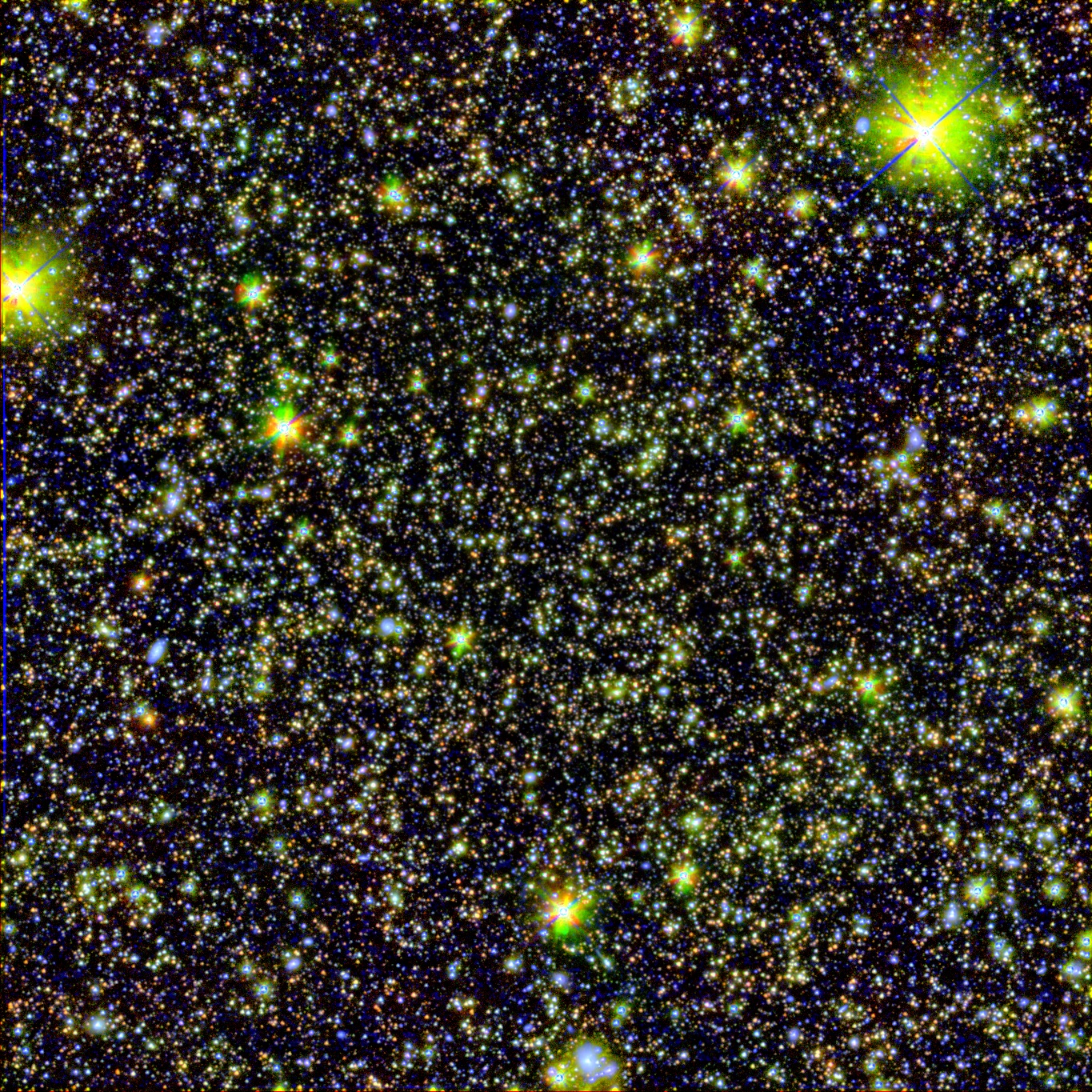
Paper on the evolution of the stellar mass function between z~6 and z~10 accepted!
August 2021
I am particularly proud to announce that our paper on the evolution of the SMF of galaxies between z~6 and z~10 has just been accepted! Stellar mass functions, i.e., the volume density of galaxies in bins of stellar mass, are one of the most fundamental statistical observables describing a population of galaxies. To “weight” a galaxy, we use the light emitted by low mass stars, which are the most abundant stars in galaxies. These stars emit most of their light in the rest-frame optical. However, the cosmological redshift shifts the light originally emitted in the optical into the near infrared (NIR). In particular, the galaxies analyzed in this study are so distant that to probe their rest-frame optical light we need to analyze data at 3-5um. While we await for JWST, we can currently only probe this wavelength regime through Spitzer. In particular, for this study, we used the deepest data available from Spitzer/IRAC over extragalactic fields from the GOODS Re-ionization Era wide-Area Treasury from Spitzer (GREATS) program. The figure below shows the new stellar mass functions (blue circles) compared to previous studies. It is remarkable how the deep IRAC data allows us to probe up to z~10!
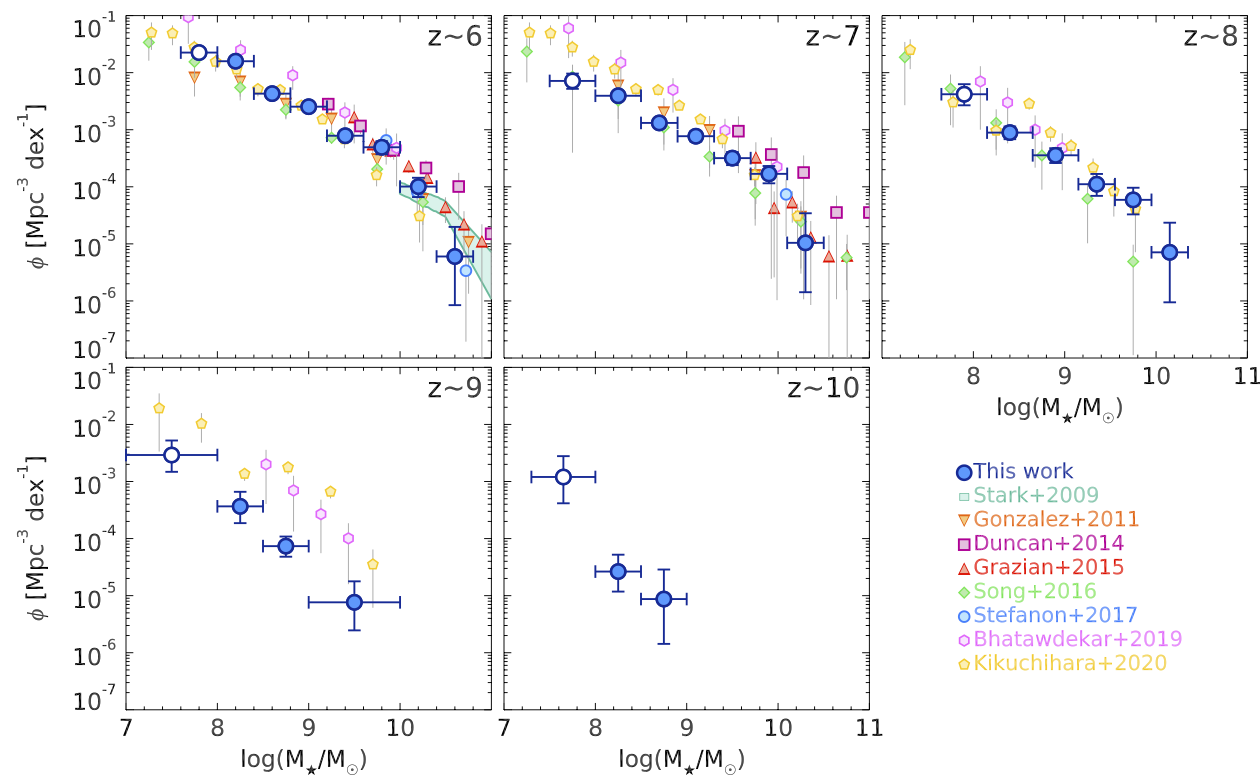
One very interesting results that we inferred from the comparison of the SMF and the halo mass function is that the ratio between the stellar mass and the mass of the hosting dark matter halo does not appear to be evolviong with time at such early epochs, but it is only a function of the halo mass (see the animation below). The ratio between the stellar and the halo mass is a key quantity, as it indicates how much more (or less) efficient the conversion of gas into stars is compared to the accretion of gas onto the galaxy driven by the potential well associated to the dark matter halo. These results suggest that (stellar) mass assembly in the first ~1Gyr of cosmic time follows that of the dark matter halos, and the plethora of evolving physcal process only have secondary effects on star formation.
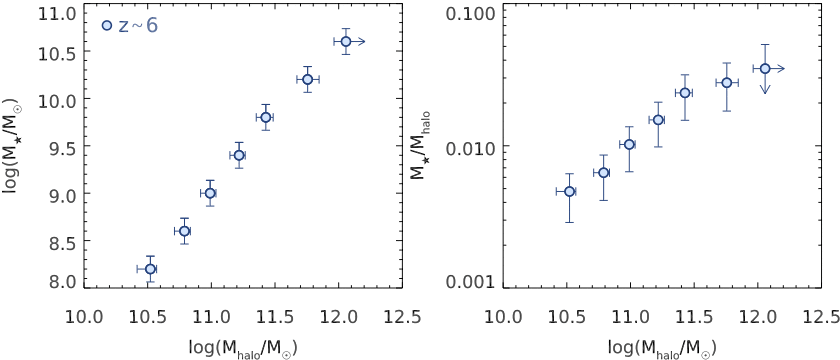
JWST proposal targeting 12 expecially bright star-forming galaxies at z~6.5-7.5
March 2021
New exciting observations targeting 12 among the brightest star-forming galaxies in the distant Universe are going to be taken by a program I am leading with the forthcoming James Webb Space Telescope (JWST). These galaxies were selected from a larger sample of ~40 galaxies from the REBELS ALMA program, led by R. Bouwens, which is providing dust continuum and ISM line emission information for this unique sample. The new JWST data will greatly complement the existing ALMA data, informing us on the stellar mass, unobscured star formation, metallicity and radiation fields of these tantalizing objects. And, last but not least, because we are going to leverage the IFU capabilities of NIRSpec (perhaps the most versatile instrument onboard JWST), all these information will be spatially resolved! To give you a sense of how powerful these observations are going to be, in the image below you can see a simulation of observations extracted from the IFU data cube for one of the sources. Stay tuned for the results from the actual observations!

New HST/WFC3 program targeting four exceptionally bright candidate star-forming galaxies at z~9
November 2019
We have been awarded, through a proposal I led, 4 orbits with HST/WFC3 to further assess the nature of 4 very promising exceptionally bright candidate star-forming galaxies at z~9 (i.e., at just ~500 Myr of cosmic time - red stars in the left panel of the above image) identified over 6 square degrees of deep ground-based and Spitzer/IRAC imaging. Securing these sources will not only allow us to test whether the efficiency of star formation at early cosmic times was higher than expected from most models (right panel). Thanks to their brightness, these sources will also enable probing the physical conditions of galaxy formation in the early Universe at S/N levels more typically obtained in observing z~1-2 galaxies!
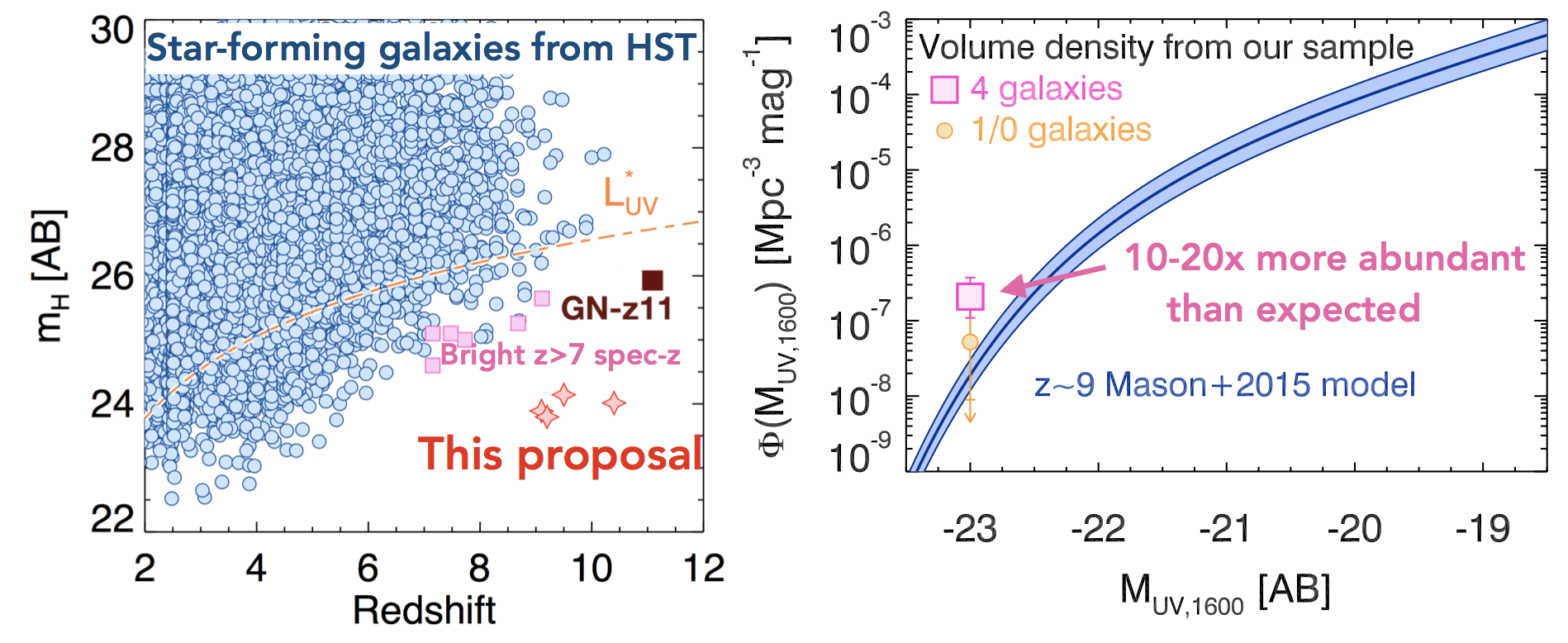
Paper on the full sample of bright star-forming galaxies at z~8 accepted!
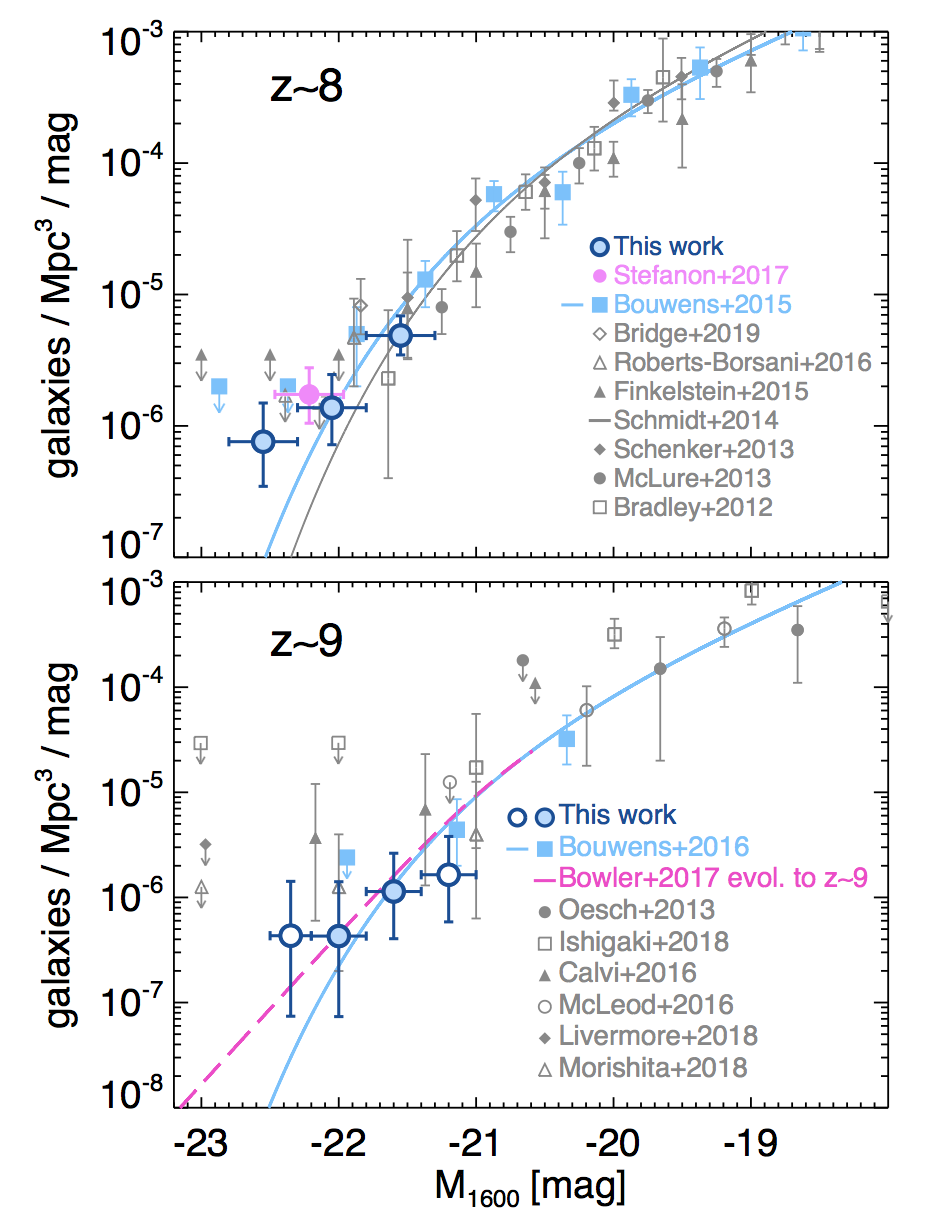
July 2019
The paper I led on the brightest star-forming galaxies at z~8 (just ~650Myr after the Big Bang) has been accepted (ApJ here, astro-ph here ! Here we describe the properties of 16 exceptionally bright (and luminous) galaxies (although one might be a merging system) we identified over the COSMOS/UltraVISTA field. Securing how many such galaxies existed at these early times (i.e., measure their volume density) has fundamental consequences on understanding how efficient star formation, feedback and dust production were at these epochs. Unfortunately, even though ours is the largest sample to date at these luminosities and redshifts, we can not yet discern whether their volume densities are higher than expected.
New Spitzer/IRAC programs to target extremely bright galaxies at z>8
June 2019
I have just been awarded ~60 hours of IRAC observations for two new Spitzer/IRAC programs targeting two dozens candidate super-bright galaxies at z>8 we identified over an area of ~6 square degrees. These observations are crucial to ascertain whether they are genuine star-forming galaxies in the young Universe or if they are old galaxies with little-to-no star-formation at much later times (~3 billion years into cosmic history). Sadly, this was the last call for observations with Spitzer, as its operations will terminate on January 30, 2020, after a glorious life of about 17 years. I guess very few people (nobody?) would have ever imagined that an "amateur-size" telescope like this (80cm diameter) could have shown to us galaxies as they looked 13 billion years ago..

New Spitzer/IRAC program to cover 1200 arcmin^2 of HST extragalactic fields
March 2019
The exciting new Spitzer/IRAC program GO^LF has been approved! Thanks to this program I am co-PI'ing with G. Brammer we will add ~600 hours of IRAC 3.6um and 4.5um observations for ~300 fields (indicated in the image below with red and blue circles) with previous optical and NIR coverage from HST, for a cumulative area of ~1200 arcmin square. These data will further enable the search for rare objects, such as extremely bright galaxies at the highest redshifts (z>8), ultramassive, quiescent galaxies at z~3-6, and brown dwarves.
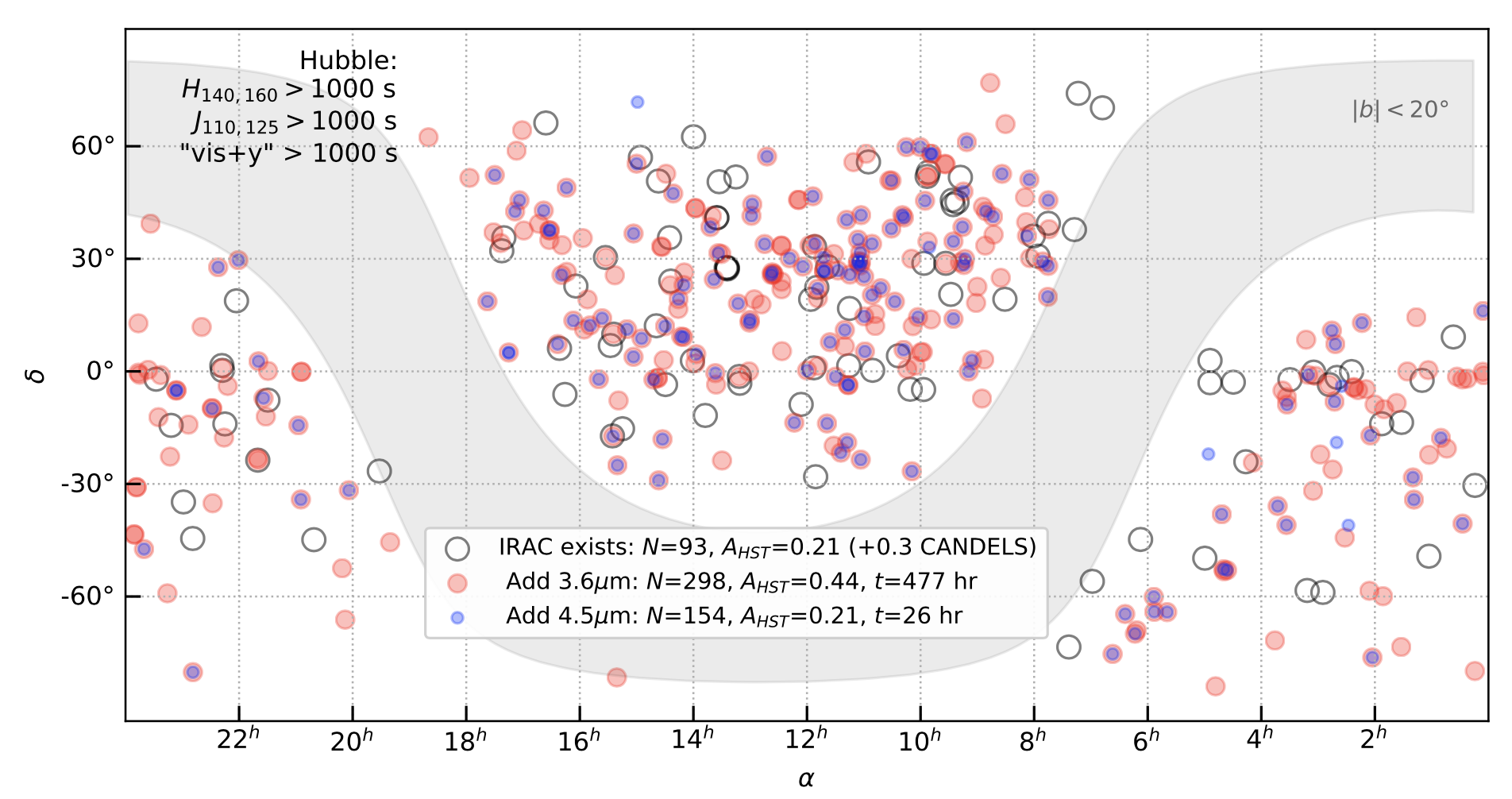
ALMA observations of bright z~8 star-forming galaxies to come
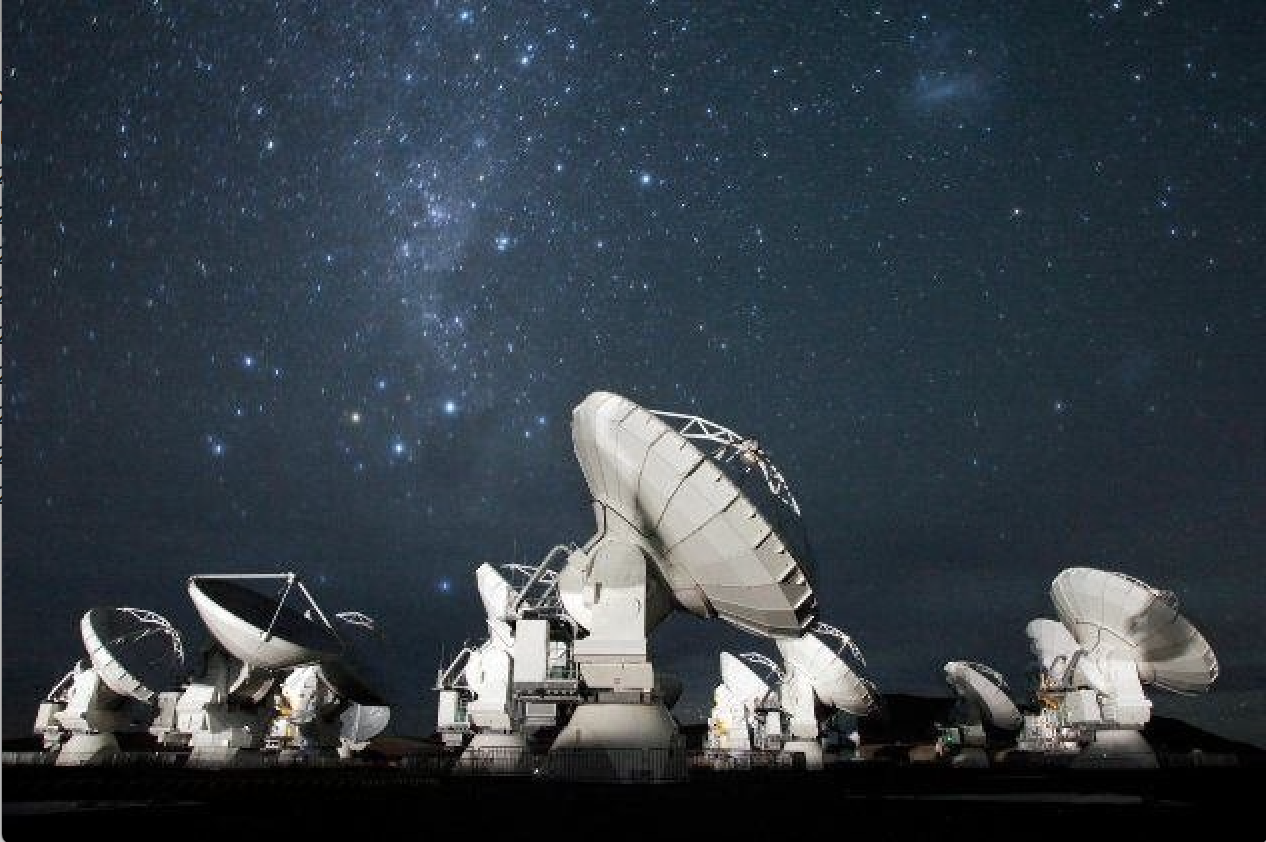
July 2018
I am PI of a recently awarded ALMA C6 program to follow-up some of the brightest candidate z~8 galaxies. The even more exciting news is that preliminary analysis on the still incomplete observations already shows an 8-sigma detection for the dust continuum of one of the objects (Image credits: ESO/ALMA)
1000h Spitzer/IRAC time awarded for COMPLETE2!
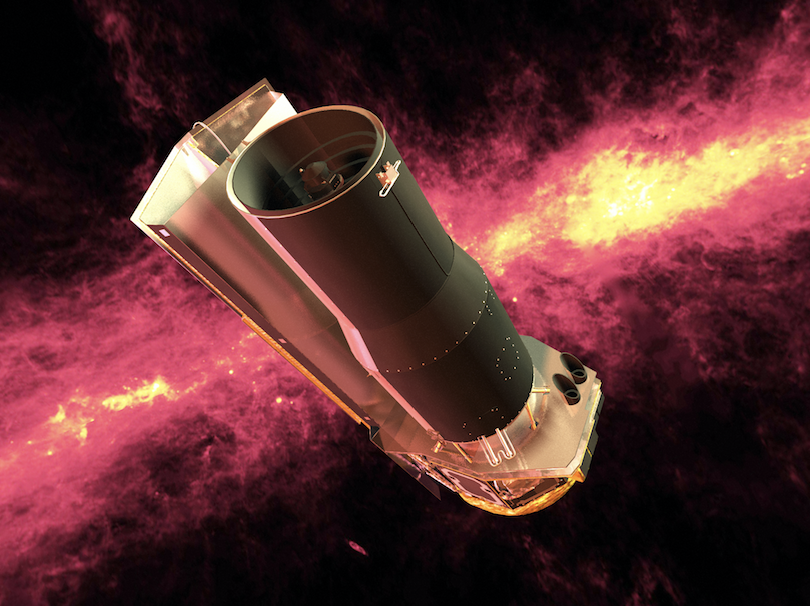
June 2018
Bright (massive) galaxies at high redshifts are extremely rare objects; their identification requires surveying large areas of the sky at NIR wavelengths to deep limits. The Spitzer/IRAC COMPLETE program of which I am Co-I (PI: Labbe’) successfully proposed to homogenise the depth over part of the UltraVISTA field.
In Spitzer Cycle 14 I successfully led new efforts to further increase the IRAC coverage by additional 1000 hours (COMPLETE2). In turn this will also increse our possibilities for identifying bright galaxies at high-z, massive-and-quiescent galaxies at z>4 and massive, dusty star-forming galaxies to z~6, currently poorly known due to limited samples size, prime targets for the forthcoming new generation of large Observatories (e..g, JWST, ELT, TMT, GMT). - Image credits: NASA/Spitzer
Bright-end of the UV LF at z~8

December 2017
One of the most intriguing discoveries of the last few years is the existence of rest-frame UV luminous galaxies at z~7-9 (e.g., Oesch+2014, Bowler+2015, Morishita+2018, Livermore+2018, with a record holder at z~11 - Oesch+2016), some of which detected over small areas (e.g., Roberts- Borsani+2015, Oesch+2016). Such systems indicate that the formation of massive galaxies could have been a rather established process just 400-600 Myr after the Big Bang; nevertheless they constitute a challenge to galaxy formation models, currently unable to reproduce these observations. Furthermore, an increasing number of Lyα detections recently found for bright z~7-8 Lyman-break galaxies (LBGs) suggests that bright galaxies could have played a role during the re-ionization, by creating large bubbles of ionised Hydrogen around them.
To further ascertain their properties and the condition of star-formation in massive systems, we have performed a systematic search of LBGs over the 0.8 sq. deg. of the ultra-deep stripes of the COSMOS/UltraVISTA survey. The search led to the identification of 15 bright (mK<25.5 AB, L>L*) LBGs at z~8. In Stefanon et al. (2017c) we presented the results of follow-up HST/WFC3 imaging for five among the brightest candidates in the sample, confirming three of them to be at z>8. The resulting luminosity function are shown in the two panels on the left. We do not observe a significant deviation from the Schechter form, although the large uncertainties do not allow us to distinguish between a Schechter and a dual power-law form.
Rest-frame z’-band luminosity function at 4<z<7
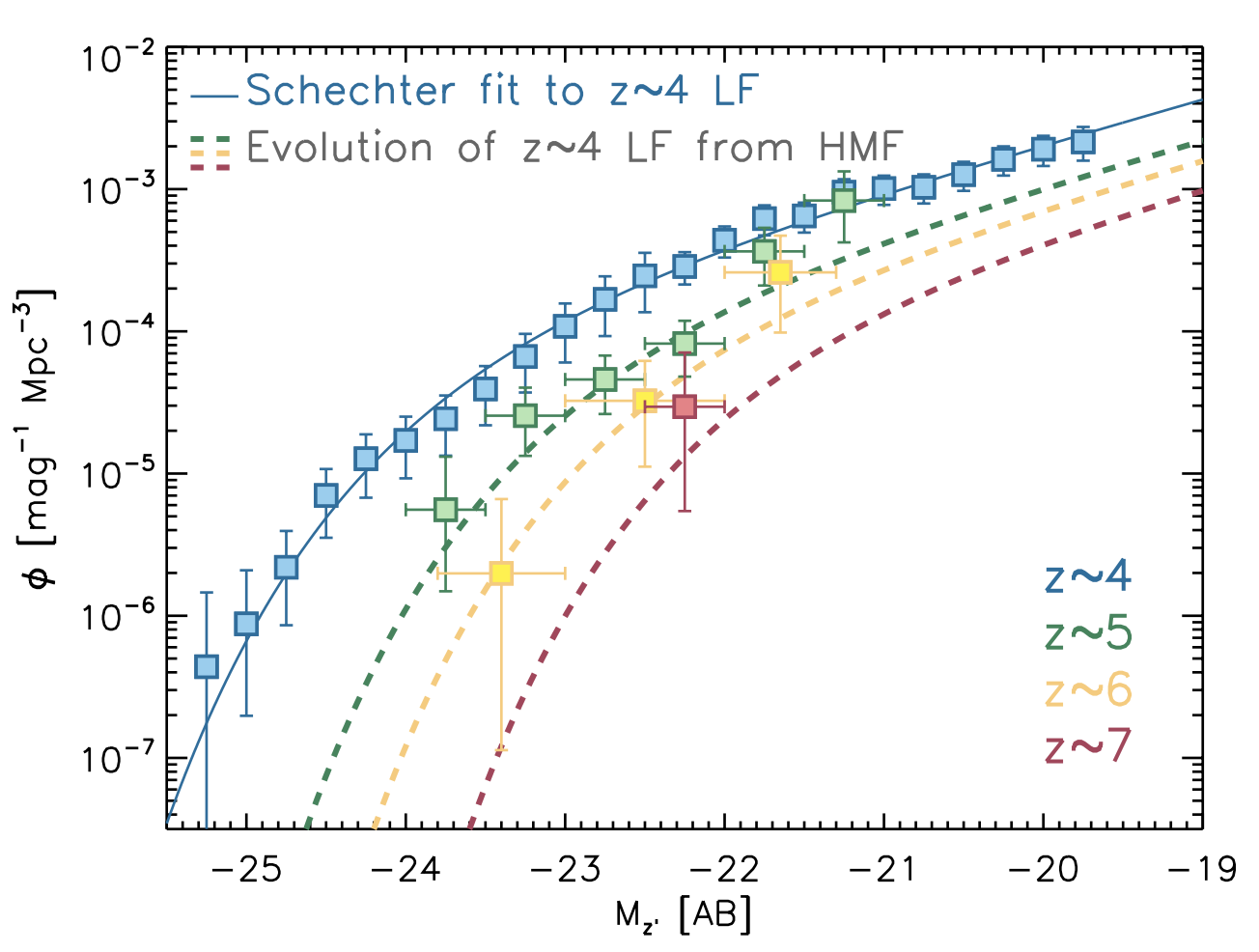
July 2017
In the last decade general consensus has been gathering around the dependence of the efficiency of the star-formation on the halo mass, with lower (i.e. inefficient) values at the high- and low-mass ends. While this seems to be established in the local Universe, it is still highly debated whether the characteristic shape of the star-formation efficiency depends on cosmic time or not, both in models (e.g. Behroozi+2018 vs. Tacchella+2018) and observations (e.g., Finkelstein+2015b vs. Harikane+2018).
Abundance matching techniques applied to stellar mass functions are an effective way of probing the star-formation efficiency. Stellar mass measurements rely on the rest-frame optical light, which is probed by Spitzer/IRAC at z≳4. Recent studies have shown that galaxies at z≳4 are likely characterized by strong nebular emission lines in the rest-frame optical (e.g., Hα, [OIII], Hβ - Stark+2013, Smit+2014), which can bias the estimates of stellar mass. To reduce the potential systematic uncertainties in stellar mass measurements, in Stefanon et al. (2017b) we explored for the first time the evolution of the rest-frame z’ band luminosity function (LF) at 4<z<7 (Figure on the left) using a composite sample of galaxies from the UltraVISTA and GOODS fields.
The interesting point about this figure is that, while the solid blue curve is a fit to the (blue) data points, the dashed colored curves are not the result of any fit. They are simplythe evolution of the blue curve according to the realtive evolution of the halo mass function, and suggest no evolution of the star-formation efficiency at these redshifts.
Massive-end of the galaxy stellar mass function at 4<z<6

October 2015
Whenever we implement a multi-wavelength catalog of objects, do we miss anything? If so, what class of objects are we missing? In Stefanon et al., (2015) we tried to answer this question for one specific catalog (Muzzin et al., 2013). As previous studies also indicate (e.g., Caputi et al., 2011), we usually miss very red objects. It turns out that some of these objects are candidate high-z-redshift galaxies.
In Stefanon et al. (2015) we measured the evolution of the stellar mass function of massive galaxies at 4<z<6. Key to this work was the assembly of a sample of galaxies selected at rest-frame wavelengths redder than the Balmer break (obtained from Spitzer/IRAC data), allowing us to lower the completeness limit in stellar mass by a factor ~10x with respect to the limit from Ks-detected samples (i.e., the parent catalog).
Furthermore we showed how the massive end of the 4<z<6 SMF is still dominated by systematics and incompleteness, due to our current limited knowledge on the spectral energy distributions of high-z galaxies that can strongly influence (and potentially even bias) the recovery of photometric redshifts and stellar population parameters for z≳4 galaxies.
What are the progenitors of the massive, compact, quiescent galaxies at z~2?
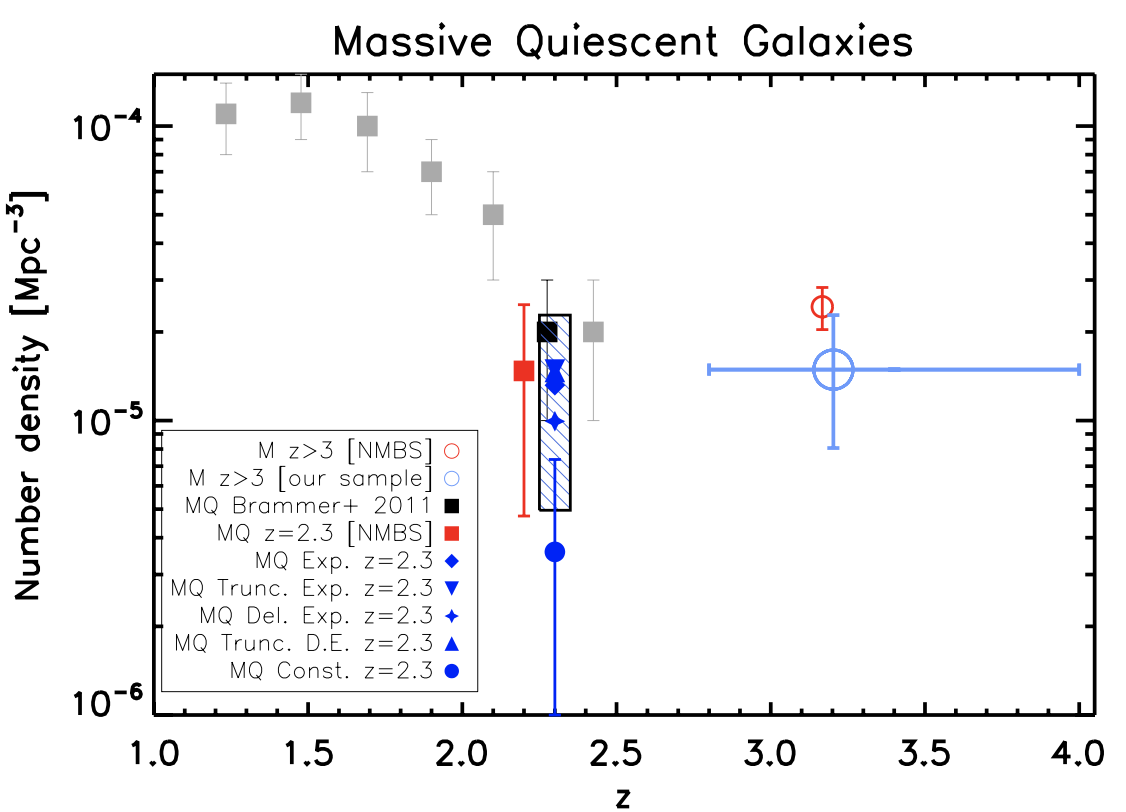
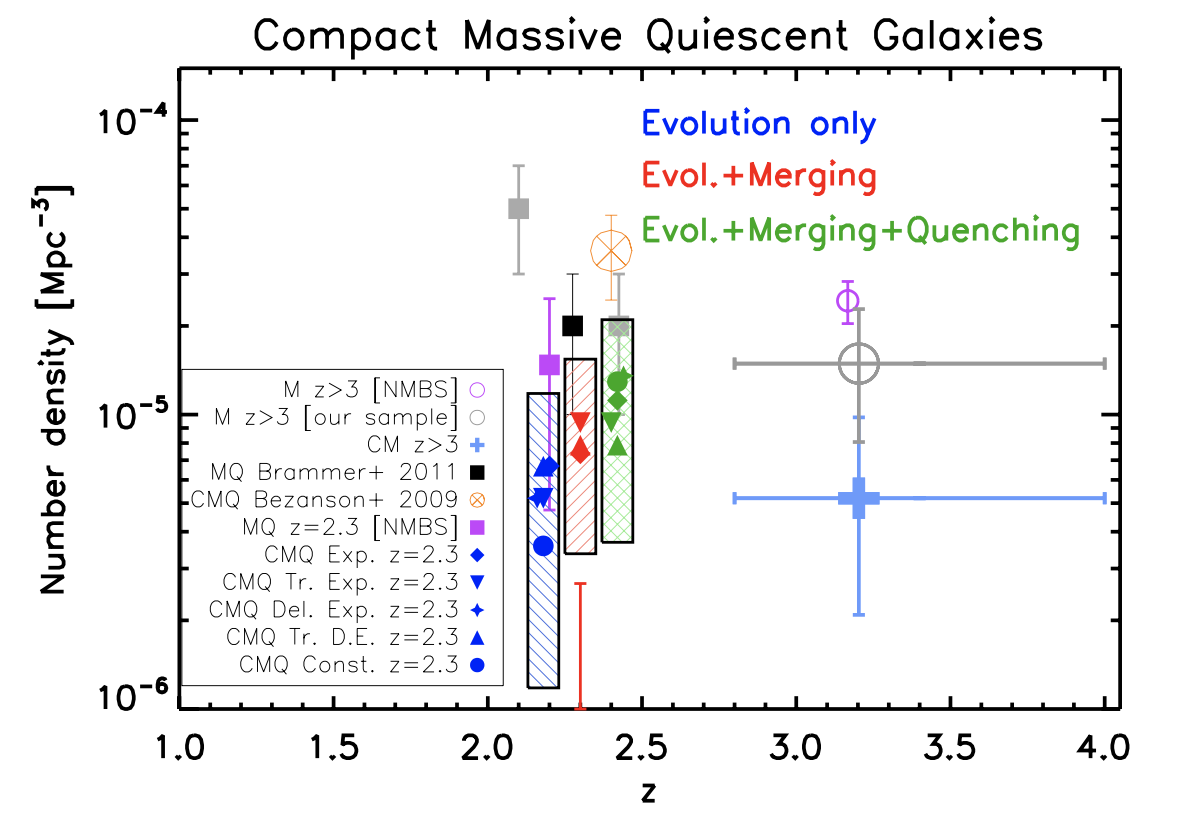
May 2013
The massive and massive-and-quiescent galaxies observed at z~2 are considered to be the progenitors of the monster elliptical galaxies we observe in our local Universe. But where do those galaxies come from? What are their progenitors?
In Stefanon et al. (2013) we selected all the massive galaxies (both quiescent and star-forming) at z>3 from the NMBS catalog. Their number density is consistent with that of the massive-and-quiescent galaxies observed at z~2 (the blue open circle at z~3 in the top panel). This is encouraging as it means that at z~3 we already have all the galaxies that can potentially become massive and quiescent by z~2. Can they?
A very simple toy model tells us that a simple evolution according to common star-formation histories is barely sufficient to explain the observed number densities at z~2 (the blue bar in the bottom panel). A much better agreement is found assuming that massive galaxies merge (red bar) and all massive quiescent galaxies at z~3 also stop forming stars by z~2 (red bar).
Leiden Observatory
Niels Bohrweg, 3
2333 CA
Leiden
The Netherlands
skype: m_stefanon